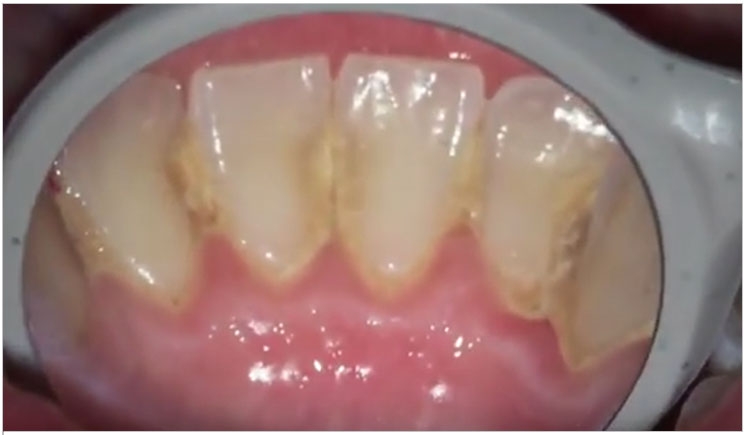
Most people think they know how to brush their teeth. Most don’t. Dentists understand that this dichotomy exists, but they typically struggle to convince patients that they can and must do better.
In many cases, the challenge is because the problem, the consequences, or both are hidden. For example, one of my patients is an investment banker in her thirties who is diligent about brushing. Yet she would always miss a groove on the outside of her last molar, and decay set in. She was unaware of this, since it hadn’t advanced to the point of pain. I videotaped the area when I discovered the decay during a cleaning appointment exam and scheduled a follow-up for removal and a filling.
When she returned for that appointment two weeks later, I initially did not see the decay. Upon closer inspection, it turned out to be hidden under a fresh layer of plaque. Every other area on that molar was spotless. I videotaped the spot a second time and showed her. She then understood why, even with a great deal of cleaning effort, she was still getting decay. There are two morals to this story.
First, even people who brush and floss diligently still miss not only a lot of surfaces, but typically the same spots. One reason is because they don’t watch themselves in the mirror, and even if they do, they have limited visibility.
Other cleaning activities in life require people to create access so they can adequately see and reach the object that needs to be cleaned. The future of oral hygiene will take a great leap forward when people are empowered to have clear access to their teeth, so they can clean the sides and concavity of every tooth. As a result, the grooves and other places where plaque builds up will be removed, and the subsequent tooth and gum destruction will be diminished.
Second, unless the plaque or decay has advanced to the point that it’s noticeable or painful, patients are unaware of the problem. This is understandable. I use a microscope and loupes to treat the patient. Patients have neither. How can we expect them to see decay with their naked, untrained eyes?
For patients, ignorance isn’t bliss because eventually they pay the price. Sometimes it’s in the form of the discomfort and cost of a filling, crown, root canal, extraction or gum graft, to name just a few. Or it could be decades from now in the form of dementia, heart disease, and other systemic conditions now known to be associated byproducts of poor oral hygiene.1,2,3
In fact, these long-term consequences could reach epidemic proportions. People are living longer, so they’ll increasingly have to deal with oral-hygiene-related conditions that previous generations didn’t simply because they died at a younger age.
Time for A Paradigm Shift
The good news is that most people can be taught how to take better care of their teeth and gums. The bad news is that there are several reasons why this is easier said than done.
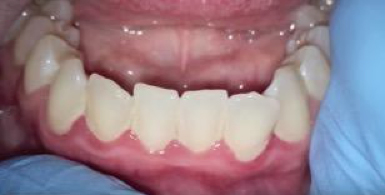 |
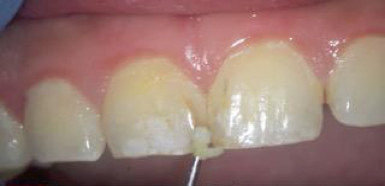 |
|
Figure 1: A “busy life” leaves no time to care for teeth. |
Figure 2: Plaque can hide in the mouth very well. |
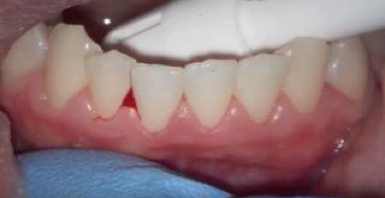 |
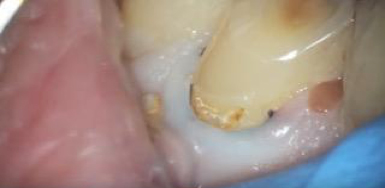 |
|
Figure 3: Use video to explain bleeding gums. |
Figure 4: Plaque can seep under fillings. |
Most dental practices are designed around treatment rather than teaching. For example, the displays in exam rooms typically are there to show x-rays rather than videos about how to brush and floss more effectively. That’s a shame because there’s no shortage of instructional videos that practices can purchase to share with patients.
In my office, the initial exam is the best time to teach people about their dental health. Typically, a 10-minute video of the patient’s mouth creates an eye opening experience, where patients understand their current dental problems. They are in a teachable state and want to know how they can improve their oral health. Real life videos of similar dental problems also show how improvement can occur when the patient participates. My hygienists then reinforce the custom-made plan for each patient while they get their teeth and gums cleaned.
Also, insurance providers typically don’t reimburse for teaching. As a result, patients have to be willing to pay for the extra hour or two that it takes to learn how to use a rubber pick, how to floss without cutting their gums, and other key practices. It’s not easy convincing patients that this is a good investment, even with demonstrable payoffs such as keeping their teeth and avoiding numerous preventable conditions.
In my experience, video is key for making the case. In the hectic pace of life, oral hygiene is often left behind. When patients discover how bad their teeth and gums are becoming, they are more likely to spend the money, time, and energy to improve the situation.
Last year I had a new patient with a significant gum condition. Her gums were deteriorating, and she wanted help improving her oral health. As with all my patients, I videotape my procedures as a form of education. Though she was embarrassed to watch the video, she wanted to clearly understand the severity of her condition.
The video motivated her to change her oral care health habits. She returned for 2 sessions of cleaning and learned how to clean her mouth using a rubber tip, floss, and gentle brushing. Three months later, her condition had significantly improved. There was minimal bleeding and she had firmer gums, but most of all, she was educated on how to clean her mouth.
She has since been extremely faithful in her oral care and has had her husband come in for treatments as well. His condition was even worse because he thought he was too busy and did not think he had a problem. After seeing the video of his oral condition, he too became an exemplary student of oral care (Figure 1).
Furthermore, people typically don’t understand plaque, including how relentless it is. As a result, they don’t understand why flossing, brushing for 2 minutes, and using appliances such as rubber picks are things they have to do day in, day out.
One way I educate patients is by explaining that even after a professional cleaning, bacteria are back at work within 20 minutes, laying down a matrix (or pellicle) that becomes plaque by the end of the day. Patients often still do not understand, but a video of how sticky and tenacious plaque can be is helpful. They are motivated to keep the problems that are seen in the video from happening in their mouths (Figure 2).
Plus, patients often assume that their mouth is normal. For example, one of my new patients is 24, has never flossed, and hadn’t been to a dentist in about 3 years. She wasn’t alarmed that her
gums were irritated because she had nothing to compare them to—and probably because it never occurred to her to make a comparison.
Video was key for educating her because it was easy to show the dark red tissue in some areas and the healthy pink gum in others. My other patients have had similar epiphanies when they watch a video where I gently tap their gum with a periodontal probe, and it either bleeds or the color changes.
In my experience, there is simply nothing as effective as video when it comes to leaving a lasting impression: the kind that convinces patients to take charge of their oral hygiene (Figure 3).
Finally, many people are unwilling or unable to get past the first step. A person who never exercises gets sore after starting a regimen and gives up. Likewise, a person who has never flossed gets discouraged by the initial discomfort and gives up. Both people never reap the benefits because no one showed them how to do things correctly to minimize discomfort to get past it.
Many young adults in their twenties and thirties are open to improving their oral hygiene habits, if they can see what is occurring in their mouth. If they realize their teeth need to be taken care of for better overall health and nutrition, they will spend more effort learning how to accomplish the task. In the long term, this will save them money, pain, inconvenience, and bad breath. As more tools are developed to encourage and provide feedback on how they are doing, they will be more motivated and reap the benefits.
Older adults are perhaps the most resistant to change. They have either been relatively successful and think that they do not need any help, or they have had painful experiences that keep them away from dentistry. The ones who think they are successful are often quite unhappy when conditions in their mouth change over the years.
For example, new medications are common with aging, and the side effects of more than 300 medications can cause a dry mouth. The plaque is harder to remove when it is dried and often leads to root decay and greater advancement of periodontal disease.
Also, the accumulation of occlusal factors loosens teeth and old fillings that deteriorate, which creates cracks and grooves where plaque can hide. These fillings accumulate plaque as well as decay and can create serious problems if left untreated (Figure 4).
Finally, the years of inflammation from plaque that has been consistently missed, though periodically cleaned by the dental professional, have an effect. This can be disheartening for the dental professional because the patients have been trying as hard as they can, but slowly their condition worsens.
The bottom line is that most people think they know how to care for teeth and gums but actually don’t. The fact that roughly 90% of adults have gum disease is just one example of why that assumption is mistaken.4,5 Thus, it’s crucial that dentists and hygienists help them understand that they don’t, as well as the short-term and long-term consequences, and then educate them on how to improve their hygiene.
References
- Stewart, Ralph, MD. “Increasing Evidence for an Association Between Periodontitis and Cardiovascular Disease.” American Heart Association Journal, 04 Jan. 2016. Web. 08 June 2016.
- Singhrao, S. K., S. Harding, S. Poole, L. Kesavalu, and S. Crean. “Porphyromonas gingivalis Periodontal Infection and Its Putative Links with Alzheimer’s Disease.” National Center for Biotechnology Information. U.S. National Library of Medicine, 30 Apr. 2015. Web. 08 June 2016.
- Shoemark, D.K., and S. J., Allen. “The Microbiome and Disease: Reviewing the Links between the Oral Microbiome, Aging, and the Alzheimer’s Disease.” National Center for Biotechnology Information, U.S. National Library of Medicine, 2015. Web. 08 June 2016.
- Pihlstrom, Bruce L., DDS, Bryan S. Michalowicz, DDS, and Newell W. Johnson, MDSc. “Periodontal Diseases.” The Lancet, 19 Nov. 2005. Web. 9 June 2016.
Dr. Craig S. Kohler, DDS, MBA, MAGD, has been practicing on the North Shore of Chicago for more than 30 years. After completing his general hospital residency at Evanston Hospital, he earned his Fellowship and master’s from the Academy of General Dentistry. He has been a visiting faculty member for the Spear Institute in Scottsdale, AZ, since 2009, as well as a staff member at NorthShore University Hospital General Hospital Residency Program, Evanston, IL, since 2000. He is the also the founder and CEO of ONVI, LLC, and the inventor of the first video toothbrush, Prophix.
Related Articles
Use Video to Educate Patients and Keep Them Loyal
Use Photos and Video to Engage Your Patients in Their Care


